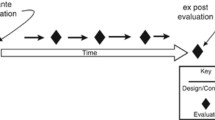Abstract
This paper investigates the effectiveness of different uses of scenarios on requirements discovery using results from requirements processes in two projects. The first specified requirements on a new aircraft management system at a regional UK airport to reduce its environmental impact. The second specified new work-based learning tools to be adopted by a consortium of organizations. In both projects scenarios were walked through both in facilitated workshops and in the stakeholders’ workplaces using different forms of a scenario tool. In the second project, scenarios were also walked through with a software prototype and creativity prompts. Results revealed both qualitative and quantitative differences in discovered requirements that have potential implications for models of scenario-based requirements discovery and the design of scenario tools.







Similar content being viewed by others
References
Agentsheets web site: http://agentsheets.com/
Alexander IF, Maiden NAM (eds) (2004) Scenarios, stories and use cases. John Wiley, New York
Alexander IF, Stevens R (2002) Writing better requirements. Addison-Wesley, Reading
Baddeley AD (1990) Human memory: theory and practice. Lawrence Erlbaum Associates, Mahwah
Bentley R, Hughes JA, Randall D, Rodden T, Sawyer P, Shapiro D, Sommerville I (1992) Ethnographically-informed systems design for air traffic control. In: Proceedings ACM conference on computer supported cooperative work (CSCW), pp 123–129
Beyer H, Holtzblatt K (1998) Contextual design: defining consumer-centered systems. Morgan-Kauffman, San Francisco
Blomberg J, Burrell M, Guest G (2002) An ethnographic approach to design. In: Jacko JA, Sears A (eds) The human–computer interaction handbook: fundamentals, evolving technologies and emerging applications. Lawrence Erlbaum Associates, Mahwah, pp 964–986
Carroll JM (2000) Making use: scenario-based design of human–computer interactions. MIT Press, Cambridge
Gottensdeiner E (2004) Running a use case/scenario workshop. In: Alexander I, Maiden NAM (eds) Scenarios, stories, use cases: through the systems development life-cycle. John Wiley, New York, pp 81–101
Haumer P, Heymans P, Jarke M, Pohl K (1999) Bridging the gap between past and future in re: a scenario-based approach. In: Proceedings of the 4th IEEE international symposium on requirements engineering. IEEE Computer Society Press, pp 66–73
Heath C, Luff P (1992) Crisis management and multimedia technology in London underground line control rooms. J Comput Support Cooperative Work 1(1):24–48
Holtzblatt K (2004) The role of scenarios in contextual design: from user observations to work redesign to use cases. In: Alexander IF, Maiden N (eds) Scenarios, stories, use cases: through the systems development life-cycle. John Wiley & Sons, New York, pp 179–209
Hughes J, King V, Rodden T, Andersen H (1995) The role of ethnography in interactive systems design. Cooperative Systems Engineering Group, Lancaster University, Technical report CSEG/8/1995
Hughes J, King V, Rodden T, Andersen H (1994) Moving out from the control room: ethnography in system design. In: Proceedings of the ACM conference on computer supported cooperative work (CSCW), pp 429–439
Jones SV, Lynch P, Maiden NAM, Lindstaedt S (2008) Use and influence of creative ideas and requirements for a work-integrated learning system. In Proceedings 16th IEEE international conference on requirements engineering. IEEE Computer Society Press
Macaulay L (1993) Requirements capture as a cooperative activity. In: Proceedings of the IEEE international symposium on requirements engineering. IEEE Computer Science Press, pp 174–181
Maiden NAM (2004) Systematic scenario walkthroughs with ART-SCENE. In: Alexander I, Maiden NAM (eds) Scenarios, stories, use cases : through the systems development life-cycle. John Wiley, New York, pp 161–178
Maiden NAM, Jones SV, Manning S, Greenwood J, Renou L (2004) Model-driven requirements engineering: synchronising models in an air traffic management case study. In: Proceedings of CaiSE’2004. LNCS, vol 3084, pp 368–383. Springer, Berlin
Maiden NAM, Seyff N, Grunbacher P, Otojare O, Mitteregger K (2006) Making mobile requirements engineering tools usable and useful. In: Proceedings of the 14th IEEE international conference on requirements engineering. IEEE Computer Society Press
Maiden NAM, Seyff N, Grunbacher P, Otojare O, Mitteregger K (2007) Determining stakeholder needs in the workplace. IEEE Softw 27(2):46–52
Mavin A, Maiden NAM (2003) Determining socio-technical systems requirements: experiences with generating and walking through scenarios. In: Proceedings of the 11th IEEE international conference on requirements engineering. IEEE Computer Society Press
Maxwell C, Millard N (1999) Integrating ethnographic field observations into requirements engineering. http://www.comp.lancs.ac.uk/computing/research/cseg/projects/coherence/workshop/Maxwell.html. Workshop—an industrial approach to work analysis and software design. http://www.comp.lancs.ac.uk/computing/research/cseg/projects/coherence/workshop.html
Robertson S, Robertson J (1999) Mastering the requirements process. Addison-Wesley, Longman, Reading, London
Sutcliffe AG (1997) A technique combination approach to requirements engineering. In: Proceedings of the 3rd international symposium on requirements engineering. IEEE Computer Society Press
Sutcliffe AG, Maiden NAM, Minocha S, Manuel D (1998) Supporting scenario-based requirements engineering. IEEE Trans Softw Eng 24(12):1072–1088
Uchitel S, Chatley R, Kramer J, Magee J (2004) Fluent-based animation: exploiting the relationship between goals and scenarios for requirements validation. In: Proceedings of the 12th international IEEE requirements engineering conference. IEEE Computer Society, pp 208–217
Viller S, Sommerville I (1999) Social analysis in the requirements engineering process: from ethnography to method. In: Proceedings of the IEEE international symposium on requirements engineering, pp 6–13
Weidenhaupt K, Pohl K, Jarke M, Haumer P (1998) Scenario usage in systems development: a report on current practice. IEEE Softw 15(2):34–45
Whiteside J, Wixon D (1988) Contextualism as a world view for the reformation of meetings. In: Proceedings of the ACM conference on computer-supported cooperative work (CSCW), pp 369–376
Zachos K, Maiden NAM, Tosar A (2005) Rich media scenarios for discovering requirements. IEEE Softw 22(5):89–97
Acknowledgments
Work reported in this paper was funded in part by the UK DTI-funded VANTAGE Phase-1 project and in part by the EU-funded FP6 027023 APOSDLE project.
Author information
Authors and Affiliations
Corresponding author
Rights and permissions
About this article
Cite this article
Seyff, N., Maiden, N., Karlsen, K. et al. Exploring how to use scenarios to discover requirements. Requirements Eng 14, 91–111 (2009). https://doi.org/10.1007/s00766-009-0077-9
Received:
Accepted:
Published:
Issue Date:
DOI: https://doi.org/10.1007/s00766-009-0077-9




